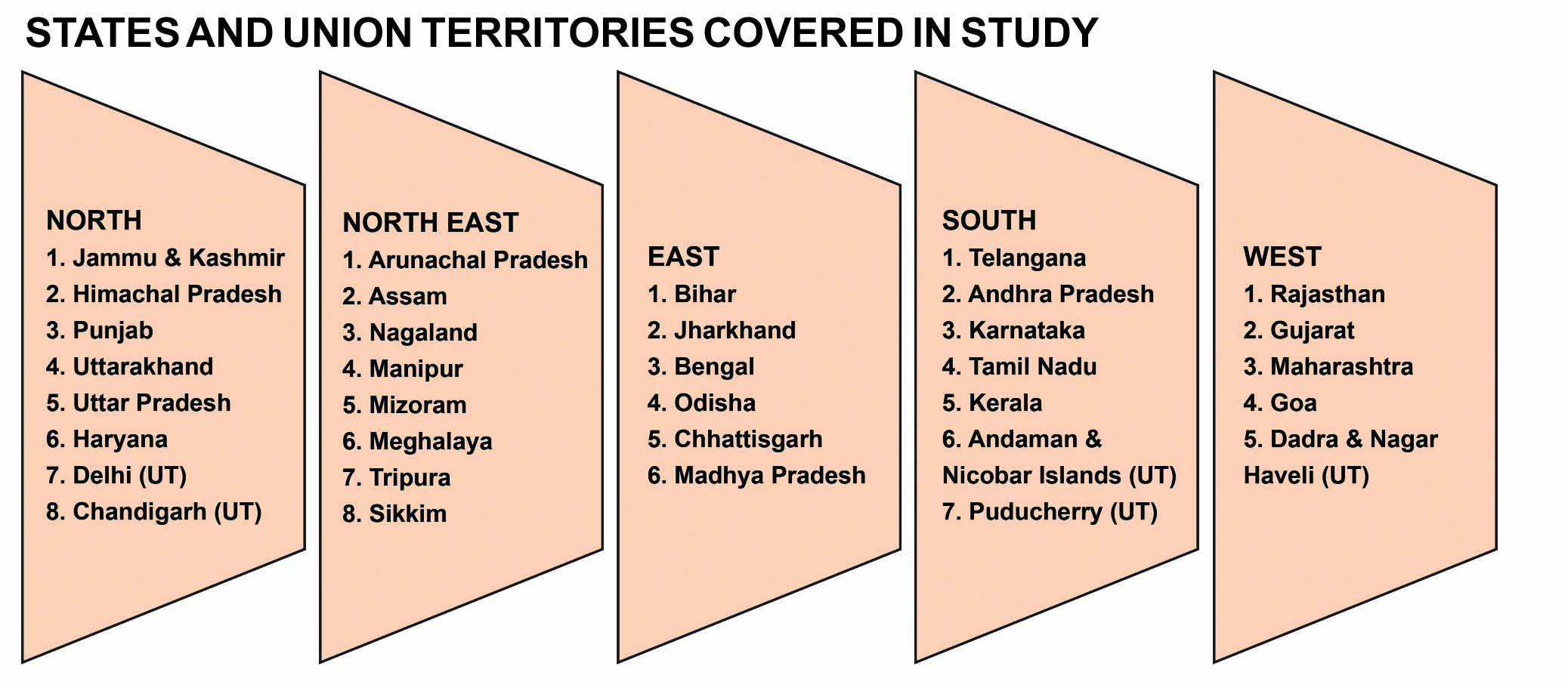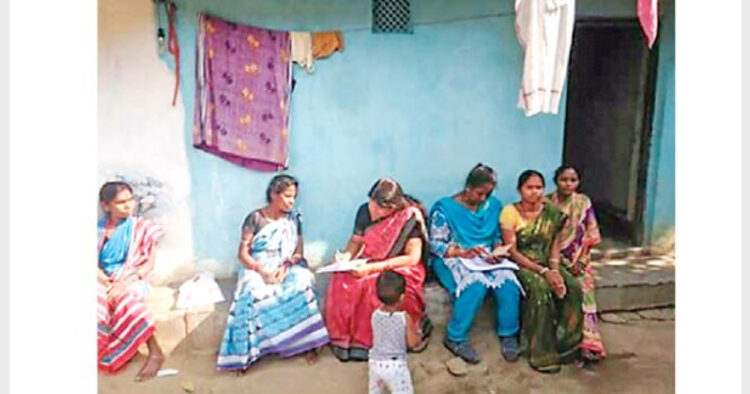
Interviews with women in urban slums during the Study by Drishti team
The findings of the nationwide study conducted by Pune-based Drishti on the condition of women in Bharat are eye-opener. They capture the obstacles the women face in their march to realise their full potential. The challenge is to design the strategies to overcome those challenges
Sandhya Jain
Indian women generally have an optimistic attitude towards life and are ready to face its myriad challenges, but need sustained support from their natal and marital homes to achieve their full potential. The principal challenges they face include overwhelming family responsibilities that can curtail their school education; acquiring skills for employment in the unorganised sector, especially in rural areas or small towns; security from sexual harassment at the work place and absence of Vishaka committee in many offices; maternity leave and access to crèche facilities which are supposed to be mandatory, but remain elusive in many places. While the condition of women could be said to be broadly satisfactory nationwide, serious intervention is needed for nomadic and Scheduled Tribe women.
These findings of a landmark nationwide survey on the status of women in society, from education, employment, health and nutrition, to happiness quotient and power equations within the family, warrant a nationwide debate. In India’s largest-ever survey, that too by a non-government group, the Pune-based Drishti Stree Adhyayan Prabodhan Kendra spent two years (2017-18) probing the condition of women in all 29 States and five of seven Union Territories, covering as many as 76,000-odd women across 464 of 727 districts (64 per cent). The survey covered 70 out of 106 border districts across 17 border states.
Nearly 7,000 surveyors, all women, were trained and fielded with comprehensive schedules tailored to wrest information from respondents across the country and across caste and community (Hindu, Muslim, Buddhist, Christian, Jain, Sikh). While the formal schedule covered three parameters of education, employment, health and nutrition, the respondents were also interviewed for intangible quality of life and happiness quotients. The main unit of analysis was women above the age of 18 years (43,255). A separate study using the same parameters covered girls below 18 years (7,675 from 25 states, two UTs and 283 districts); the remaining 25,000-odd respondents hailed from urban slums, tribal and rural areas.

A staggering achievement of the survey is that besides the overall assessment of health, education and employment of women, it yielded as many as 26 separate studies on subjects such as “Status of Women Dedicated to the Spiritual Field in India” and “Status of Women in Border Areas in India with special reference to Jammu and Kashmir”.
Surprisingly for a nation deeply invested in family and progeny (grihastha ashram), the survey found that 90 per cent of respondents who have embraced the spiritual field are among the happiest in the country. It also found that married women had very high and high levels of happiness, while those in live-in relationships had the lowest percentage of happiness, possibly because marriage brings stability and contributes to the well-being of the individual.
However, women from families with incomes below Rs 10,000 per month had lower levels of happiness. Another astonishing finding is that there is no correlation between income and happiness, and it “is almost the same in the women in all categories of employment”. Similarly, women across educational categories shared similar levels of happiness and well-being.

The happiest women were in the age bracket of 50 to 60 years, possibly because they became free of family responsibilities; while there was a decline for women above 60 years, possibly because factors such as life insecurity, health-related issues, loneliness, etc. impacted their mental status.
Officially releasing this gigantic report on September 24, 2019, RSS Sarsanghachalak, Shri Mohan Bhagwat, said women have the inherent ability to empower themselves and their families should give them the necessary access to education, freedom and opportunities, so they can beat their own path to progress. Recalling Swami Vivekananda, he said women need to be reminded of their strength and motivated to come out from their homes for social causes. Women are masters at multi-tasking and can manage home and other activities; however, the survey showed that in most families women are consulted but their opinion is not considered in actual decision-making. Men, he advised, should study this report seriously and help empower women from the homes itself.
Union Finance Minister Nirmala Sitharaman observed that women need opportunity and access to education, information and health in order to bring about change, and not token participation. Reservations in Panchayats have increased the participation of women in public life, but, as the report notes, despite the presence of 78 women MPs (the highest ever in India), not one of the 24 Standing Committees in Parliament is headed by a woman. The report adds that 13 per cent of women MPs are not members of any Standing Committee and the percentage of female MPs in a particular group of committees reveals gender stereotypes. To move ahead, Smt Sitharaman exhorted women to move out of their comfort zones and actively participate at party and government levels, utilise opportunities and accept challenges.
Drishti secretary Anjali Deshpande pointed out that such a comprehensive survey would be beneficial to central and state governments as it was multi-dimensional and besides education, health, employment and safety, it covered women in family to women in politics, women in slums to women in border areas, with authentic statistics and observations. The organisation, established in 1996, has previously conducted research on the status of tribal domestic workers brought to cities from backward regions like Jharkhand and Chhattisgarh; the trafficking of girls and their exploitation by placement agencies and others; the status of women in Haryana where girls are brought for marriage from different states. It is currently investigating the socio-economic status of women in the north-east.
The report notes that more than one-tenth of working women face sexual harassment at their workplaces, most of which lack the legally mandated internal complaint committee against sexual harassment. For instance, 61.06 per cent medical professionals in Rajasthan reported that there were no Vishaka committees in the hospitals where they worked. A disturbing finding was that most working women are not aware of the legal provisions that provide them security at the workplace. Moreover, despite several legal amendments, many women employees do not get facilities like transportation, canteen, crèche and rest room at the workplace. More than 60 per cent do not have any loan facility. Even women scientists lack crèche facility. However, the majority of women school teachers enjoy a healthy environment in their schools. In the study sample, Christian women enjoy the highest percentage of employment, followed by Hindu, Buddhist, Muslim, Jain, Sikh in descending order.

Women reported feelings of insecurity in border districts of Jammu and Kashmir (78 per cent) and West Bengal (39 per cent) due to sexual harassment, hooliganism, eve-teasing and human trafficking. Almost half the women interviewed in West Bengal border area expressed a desire to move to safer places as they faced restrictions on mobility and social interactions on account of communal atrocities. Women face threat to life in Naxal-affected Chhattisgarh. However, project director Dr Maneesha Kothekar observed that contrary to expectations, the survey revealed that implementation of government schemes is more effective in conflict areas.
The trafficking of tribal women is pervasive in almost all States. Often, the girls are sold by their parents, and those who are rescued and return home are not accepted by society. Many women who migrate to urban centres like New Delhi and Mumbai for work as domestic servants are underpaid.
There is still a wide gender gap of 23.56 per cent in literacy, though female literacy has risen from 63 per cent in 2011 to 79.6 per cent in 2018. But few manage to study beyond graduation and the drop-out rate among female students in high school is 30.7 per cent. Illiteracy is higher among Scheduled Tribe women followed by Scheduled Caste and Special Backward Class. A major obstacle to education is marriage and financial difficulties, though reservations and educational support measures have helped women from Scheduled Caste, Scheduled Tribe, Special Backward Class and Other Backward Class category to attain a higher level of education. Nearly one-fourth of the respondents reported lack of leisure time.
The gap extends to employment and wages. According to the National Sample Survey report 2011-12, average daily wage is Rs 201.56 for female and Rs 322.28 for male in rural areas, and Rs 336.15 for female and Rs 469.87 for male in urban areas. However, Drishti found that the majority of women were earning around Rs 166.66 per day, which is below the NSS figure and reveals monetary exploitation at the workplace. Unemployment levels are higher among women between 18 and 30 years, mostly due to marriage and family responsibilities. Paradoxically, female employment rate is highest in the ST category and unemployment rate is highest in the general category.
On the paradigm of health and nutrition, the survey found that while nearly 50 per cent of the women had two meals a day, 3.73 per cent could eat only once daily. More than 64 per cent girls below 18 years suffered from menstrual problems; arthritis is the second highest affliction (15 per cent), while some suffered from blood pressure (5.28%), heart problem (3.07%), diabetes (1.62%) and cancer (0.51%). As many as 40 per cent of the women surveyed had been hospitalised in the past two years; the percentage was higher for women in the spiritual field. Health problems were more among tribal women.
On the positive side, the survey found that as many as 90.62 per cent of the respondents had Aadhaar cards, which suggests that they are receiving the benefits of government schemes. Most also had Individual Bank Accounts. Data from banks shows an increase in bank account holders from 48 per cent in 2014 to 61 per cent in 2015, possibly due to implementation of the Pradhan Mantri Jan Dhan Yojana. This increases the participation of women in economic activity within the family and society. Even unemployed women have bank accounts, which is a positive sign. More surprisingly, women in conflict areas and rural areas have bank accounts, as compared to women in other rural areas. Nearly half of the girls below 18 years have bank accounts. However, the majority of women do not have PAN card as they lack a taxable or steady income; the majority reported a total family income below Rs. 20,000/per month.
However, despite being introduced way back in 1993, most women did not have a voter card. This impacts their participation in public life, especially at the Panchayat level where most decisions are made that affect their lives, from schools, to roads and transport, to skill development to market access and employment. This is a lacuna that needs to be addressed urgently. It is lopsided development if women have bank accounts and Aadhaar cards, but no voter card.
The Drishti report is an eye-opener. It captures the obstacles facing women in their march to achieve their full potential. The challenge is to find the strategies to overcome them.
(The writer is a senior columnist)













Comments